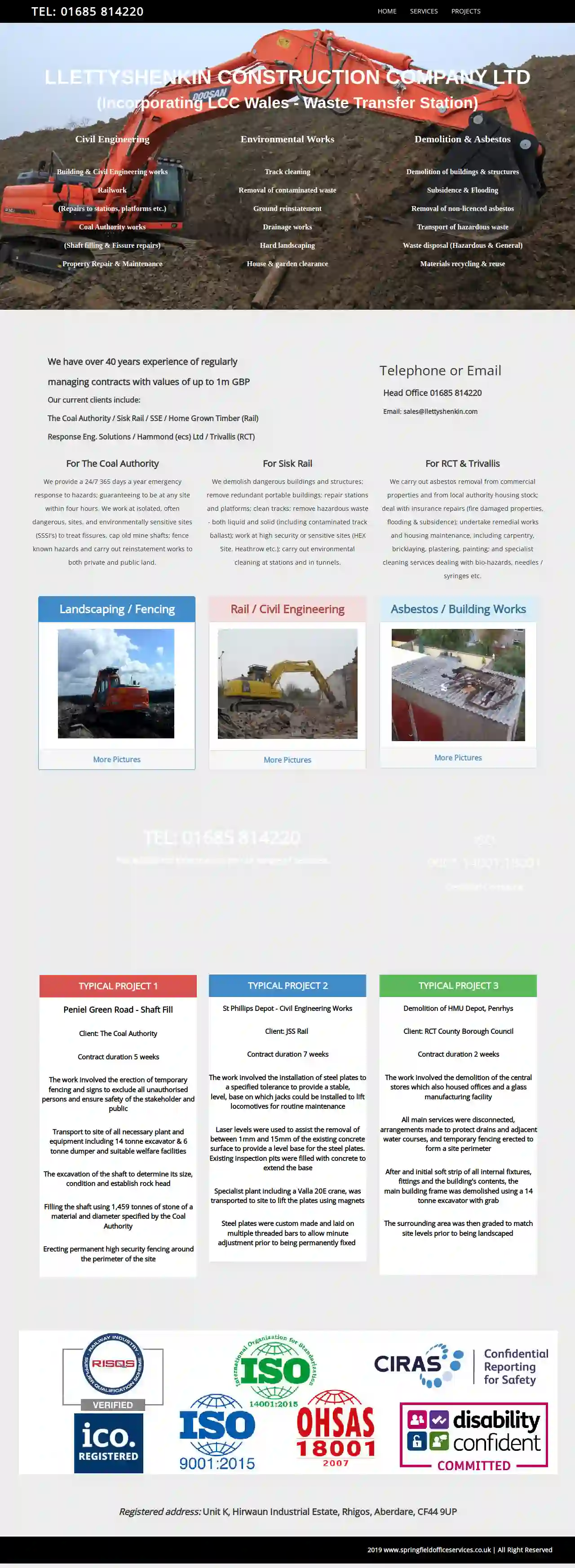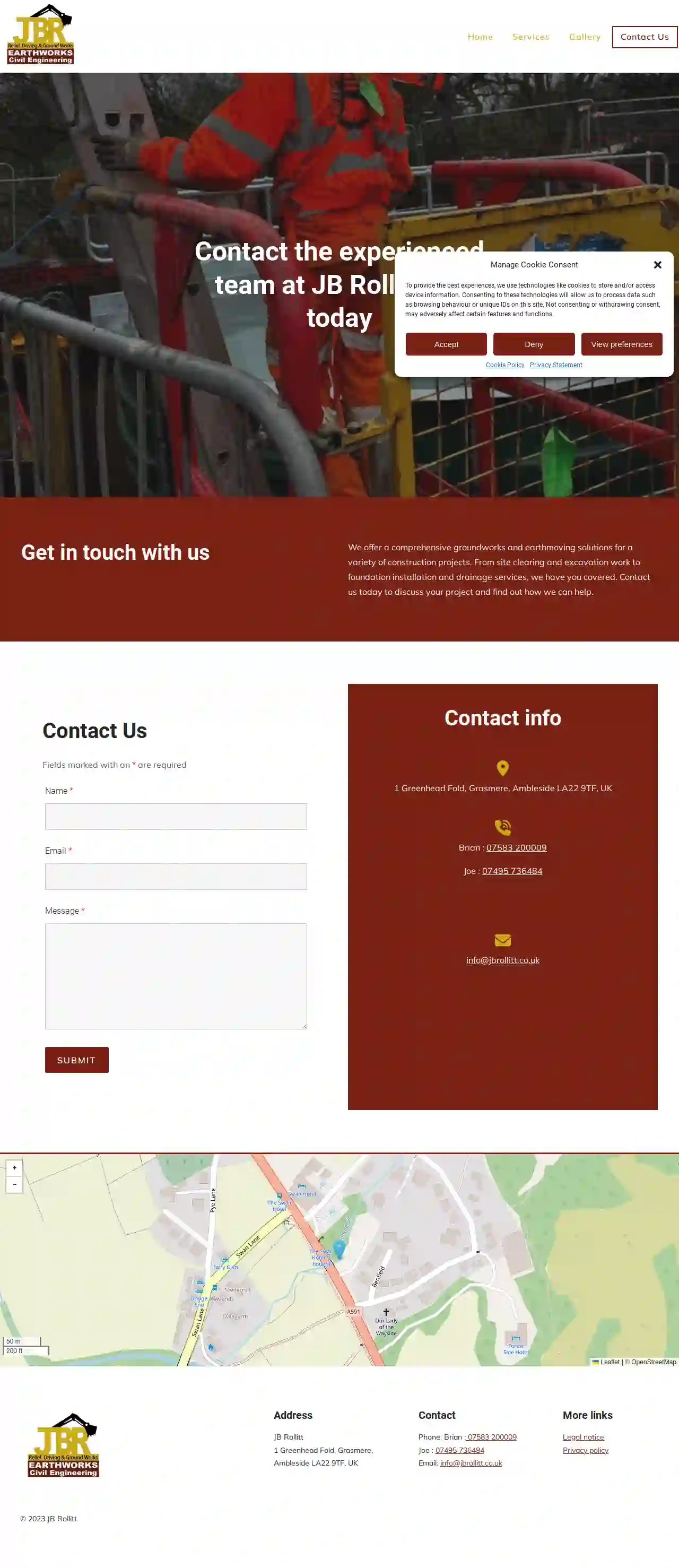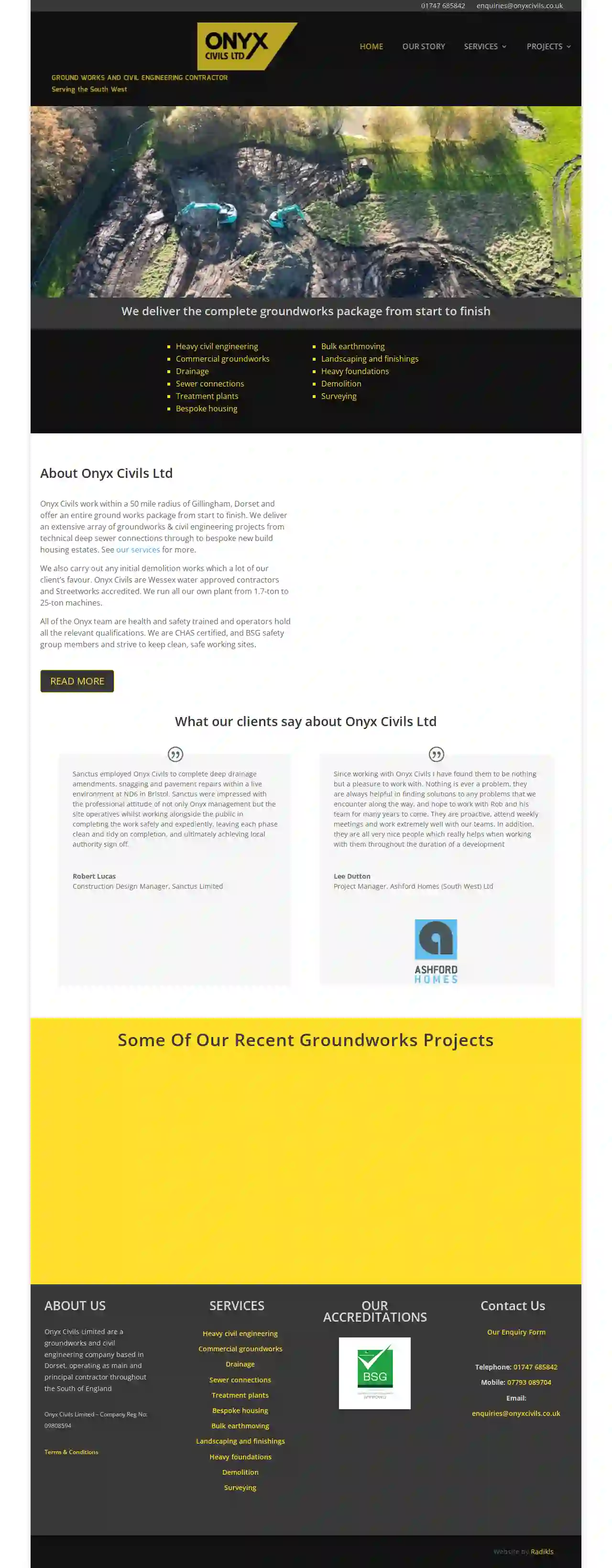Excavation Contractors Codsall
Find top Excavating Contractor in Codsall
Get 3 FREE Excavating Contractor quotes for your project today! Compare profiles, reviews, accreditations, portfolio, etc... and choose the best offer.

Van Elle Limited, Washington
51 reviewsSummit Close, Kirkby-in-Ashfield, NG17 8GJ, GBTOTAL FOUNDATION SOLUTIONS The UK's largest and most diverse geotechnical and ground engineering contractor Our core markets Offering end-to-end capabilities with over 25 specialist ground engineering techniques, we have the experience, people and assets to carry out your projects across these key sectors. Residential Integrated piling and foundation systems for national and regional housebuilders, retirement and multi-storey residential. Infrastructure Specialist ground engineering services to the rail, highways, coastal and flooding, energy and utility sectors. Construction Full range of piling and ground improvement services to the commercial, industrial and residential sectors. Start a conversation today! If you have any questions or queries a member of staff will always be happy to help, please feel free to contact us by telephone or email and we will get back to you as soon as possible. Contact Us >
- Services
- Why Us?
- Gallery
Get Quote
Llettyshenkin Construction Co Ltd
3.84 reviewsUnit K, Hirwaun Industrial Estate, Rhigos, Aberdare, CF44 9UP, GBLletty Shenkin Construction Company Ltd (Incorporating LCC Wales - Waste Transfer Station) Lletty Shenkin Construction Company Ltd is a well-established and reputable construction company with over 40 years of experience in the industry. We offer a wide range of services to meet the needs of our clients, from civil engineering and building works to railwork, coal authority works, property repair and maintenance, environmental works, demolition and asbestos removal, and waste disposal. We are committed to providing our clients with the highest quality of service and workmanship. We have a team of experienced and qualified professionals who are dedicated to delivering projects on time and within budget. We are also committed to safety and environmental responsibility, and we have a strong track record of working safely and sustainably. We have a proven track record of successfully managing contracts with values of up to 1m GBP. Our current clients include The Coal Authority, Sisk Rail, SSE, Home Grown Timber (Rail), Response Eng. Solutions, Hammond (ecs) Ltd, and Trivallis (RCT). We are proud to be a ISO 9001, 14001, 18001 certified company, which demonstrates our commitment to quality, environmental responsibility, and health and safety.
- Services
- Why Us?
- Gallery
Get Quote
RBS Building Contractors
52 reviews25 Caburn Way, Hailsham, East Sussex, BN27 3LX, GBRBS Building Contractors: Your Trusted Sussex Builders RBS Building Contractors is a family-run business with over 30 years of experience in the building and construction trade. We're based in East Sussex and have built a strong reputation for quality workmanship and customer satisfaction throughout the Sussex and South East area. Whether you're looking for a kitchen installation, an extension, or a new build construction, we're here to help. We're committed to providing our clients with the highest quality service and attention to detail. Get in touch today to arrange a free quotation for your next building project.
- Services
- Why Us?
- Gallery
Get Quote
Kingscroft Construction Ltd
51 reviewsCannock, GBWelcome to Kingscroft Construction Limited Kingscroft Construction is a family-run business with over 35 years of experience in the building industry. We are based in Cannock and serve a wide area, including Burton, Stone, Rugeley, and Wolverhampton. We are fully insured and offer free quotations and estimates. Our Services We offer a wide range of building services, including: New Build Projects Extensions Restoration / Renovation Replacement Fascia & Guttering Garage Conversions Windows & Door Replacement Internal Alterations including Structural Openings Block Paving Plumbing & Heating Installations Electrical Installations & Alterations Kitchen Design & Installations Why Choose Kingscroft Construction? We are a highly experienced and professional business with a growing reputation for completing all work to an exceptionally high standard. We are committed to providing our clients with a high-quality service and ensuring that their individual requirements are met. We are also proud to be members of the Guild of Master Craftsmen and the Stoke on Trent Trader Register.
- Services
- Why Us?
- Testimonials
- Gallery
Get Quote
W. Tollett General Builders Ltd
Harbour Road, Rye, East Sussex, TN31 7TE, GBDomestic & Commercial Builders in Rye & the South East W. Tollett General Builders offer a comprehensive range of building services. You don’t need to look for individual plumbers, electricians, carpenters, or bricklayers as we have an experienced team of in-house specialists to manage the whole project – no matter how big or small. Our priority is to provide a top quality and an affordable building service, we look after each step until completion, to ensure you’re completely satisfied with the end result.
- Services
- Why Us?
- Gallery
Get Quote
JB rollitt limited
41 reviews1 Greenhead Fold, Grasmere, Ambleside, LA22 9TF, GBWELCOME TO JB ROLLITT JB Rollitt is a family-run business with a strong reputation for providing high-quality groundworks and engineering services throughout the UK. We are a father and son team with a wealth of experience in the industry, and we are committed to providing our clients with the best possible service. We have worked on a wide range of projects, from small domestic jobs to large-scale commercial developments. We are also proud to have worked with some of the UK's leading construction companies, including Morgan Sindall, Ministry of Defence, JN Bentleys, Hubbways Plant Hire, Skanska, local government, BAE Systems, Welsh Water, Northumberland Water, Brendon's Quarries, Northumberland Local Council, Cumbria County Council, Network Rail, Costain, Highways England, Story Construction, and Galliford Try. Our team is highly experienced and skilled in all aspects of groundworks and engineering, and we are committed to providing our clients with a safe and efficient service. We are also fully insured and accredited, so you can be confident that you are in safe hands. We are proud of our reputation for quality, reliability, and customer service. We are committed to providing our clients with the best possible service, and we are always happy to go the extra mile to ensure that they are satisfied. If you are looking for a reliable and experienced groundworks and engineering company, then look no further than JB Rollitt. We are confident that we can provide you with the service you need to get your project off to a great start. We offer a comprehensive range of services, including: • Site clearing • Excavation work • Foundation installation • Drainage services • Kerbing • Tarmac driveways • Tennis courts • School yards • Sports clubs • Stone driveways • Emergency drainage services • Relief driving for all types of machinery We are also available 24 hours a day for emergency callouts. We are committed to providing our clients with the best possible service, and we are always happy to go the extra mile to ensure that they are satisfied. Get in touch with our team of professionals for expert advice or a free quotation. Our experts are available 24 hours a day to help with any building project.
- Services
- Why Us?
- Gallery
Get Quote
Bromsgrove Builders Ltd
9 Lincoln Road, Bromsgrove, B61 8SE, GBBromsgrove Builders - Over 20 Years Building Experience! Bromsgrove Builders are your local building and roofing specialists. We offer a full suite of building services, including new home builds, extensions, loft and garage conversions, roof repairs, property restoration, renovation, repair, maintenance and refurbishment. We also look after interiors too, with bathroom and kitchen redesign and installation. In fact, we can look after everything including your garden offering a full landscaping design service that includes fencing, ponds and outside walls. Bromsgrove based builder Darren Byng has been serving the Bromsgrove, Midlands area for over 30 years offering top quality service as standard. The company prides itself on using a professional team of skilled tradesmen and regular subcontractors. Bromsgrove Builders are members of the Federation of Master Builders and registered with Trust Mark - Look them up! All building work is offered with the reassurance of a 12 month guarantee. Darren Byng, the Managing Director has over 30 years experience of working in the buildings industry. Darren oversees all projects from start to finish. Bromsgrove Builders Ltd are dedicated to delivering the best possible customer service. Their results speak for themselves with 95% of all work coming from personal recommendation.
- Services
- Why Us?
- Accreditations
- Our Team
- Gallery
Get Quote
Onyx Civils Ltd
51 reviewsGillingham, GBOnyx Civils: Your Trusted Groundworks Partner in the South West Onyx Civils is a family-run business with a passion for delivering exceptional groundworks and civil engineering solutions. We're based in Dorset and operate throughout the South of England, providing a comprehensive range of services to meet your project needs. Our Story: From Humble Beginnings to a Leading Groundworks Contractor Our founder, Rob Williams, has been involved in the construction industry since childhood. His passion for machinery and construction led him to pursue a career in heavy plant mechanics, gaining valuable experience working on various projects for local councils and Wessex Water. In 2012, Rob established himself as a sole trader, quickly building a reputation for quality and reliability. As demand grew, he formed Williams Plant, expanding his services and fleet of machinery. In 2016, Rob and his wife Fiona, who had always been a key part of the business, decided to form a limited company. With a dedicated team of experienced operators and ground workers, Williams Plant Dorset Ltd secured significant contracts as both a main and principal contractor. In 2020, the company was renamed Onyx Civils Limited, reflecting their commitment to excellence and the values they hold dear. Onyx, meaning 'claw' in Greek, also represents a rare precious stone symbolizing positivity, determination, stamina, perseverance, and courage – qualities that define Onyx Civils' approach to work. Our Commitment to Quality and Safety At Onyx Civils, we prioritize safety and quality in everything we do. Our team is fully trained in health and safety, and our operators hold all the necessary qualifications. We are CHAS certified and members of the BSG safety group, ensuring a clean and safe working environment on all our projects. We also operate our own fleet of machinery, ranging from 1.7-ton to 25-ton machines, giving us the flexibility to handle any project. What Our Clients Say "Sanctus employed Onyx Civils to complete deep drainage amendments, snagging and pavement repairs within a live environment at ND6 in Bristol. Sanctus were impressed with the professional attitude of not only Onyx management but the site operatives whilst working alongside the public in completing the work safely and expediently, leaving each phase clean and tidy on completion, and ultimately achieving local authority sign off." - Robert Lucas, Construction Design Manager, Sanctus Limited "Since working with Onyx Civils I have found them to be nothing but a pleasure to work with. Nothing is ever a problem, they are always helpful in finding solutions to any problems that we encounter along the way, and hope to work with Rob and his team for many years to come. They are proactive, attend weekly meetings and work extremely well with our teams. In addition, they are all very nice people which really helps when working with them throughout the duration of a development." - Lee Dutton, Project Manager, Ashford Homes (South West) Ltd
- Services
- Why Us?
- Testimonials
- Gallery
Get Quote
Platinum Groundworks
58 reviewsHole Farm, Westfield Lane, Hole FarmWestfield LaneHastingsEast Sussex, Hastings, TN354SA, GBPlatinum Groundworks: Your Trusted Groundwork and Demolition Experts in the Southeast Platinum Groundworks is a leading provider of groundwork and demolition services in the Southeast. We have a team of highly experienced professionals with a deep understanding of groundwork, construction, and demolition. We specialize in all types of foundations, from rafts to strip foundations, and handle all drainage needs, including treatment plant installations. Our expertise extends to bulk excavations, retaining walls, underpinning, block and beam construction, reinforced concrete, and more. We also offer finishing services for your new build project, including patios, paths, concrete bases, and driveways. Our commitment to excellence is reflected in our dedication to delivering projects on time, within budget, and with 100% client satisfaction. We pride ourselves on our reputation and the high volume of work we receive through recommendations, word of mouth, and repeat business. We work with both large commercial clients and private homeowners, ensuring a personalized and professional approach for every project.
- Services
- Why Us?
- Testimonials
- Gallery
Get Quote
J H Hicks Demolition Limited
34 reviewsUnit 03ParchFields Enterprise Park, Colton RoadRugeley, Staffordshire, Unit 03ParchFields Enterprise ParkColton RoadRugeley, Rugeley, WS15 3HB, GBAbout J H Hicks Demolition Since 1994, J H Hicks Demolition has been a leading force in the fields of demolition and deconstruction. Our commitment revolves around delivering a reliable and secure service while adhering to the highest standards of health and safety practices. With a diverse portfolio, we've successfully completed projects of various scales and complexities across the UK. We take immense pride in showcasing our unparalleled expertise across a spectrum of services, including Demolition, Stripouts, Asbestos Removal, Site Clearance, and Reclamation projects. With a proven track record of excellence, our skilled team consistently delivers exceptional results in every aspect of these specialized fields.
- Services
- Why Us?
- Gallery
Get Quote
Over 13,059+ Excavation Businesses on our directory
Our excavation contractors operate in Codsall & surroundings!
ExcavationHQ has curated and vetted the Best Excavation Pros in Codsall. Find the most reliable business today.
Frequently Asked Questions About Excavation Contractors
- Hauling to Designated Disposal Sites: Transporting excavated material to approved landfills or recycling centers.
- Recycling or Reuse: If suitable, some excavated soil might be recycled for other projects or reused on-site for landscaping or backfilling.
- Complying with Regulations: Adhering to local and environmental regulations for soil disposal to prevent contamination or illegal dumping.
- Utility Locates: Contact your utility companies to mark the locations of underground lines before excavation begins. This is usually a free service.
- Hand Digging: Excavate carefully by hand near marked utility lines to avoid damage.
- Potholing: Digging small test holes to expose and verify utility depths and locations.
- Safe Distances: Maintaining a safe distance between excavation equipment and marked utility lines.
- Vacuum Excavation: Using vacuum excavation techniques to expose utilities without digging, reducing the risk of damage.
- Project Size and Scope: Larger, more complex excavations naturally take longer.
- Soil Conditions: Rocky or challenging soil types can slow down progress.
- Site Accessibility: Limited access might require more time for maneuvering equipment and hauling materials.
- Weather: Inclement weather can cause delays.
- Permitting and Inspections: Waiting for permits or inspections can extend the timeline.
How do you handle soil disposal after excavation?
What is the difference between topsoil and subsoil?
Topsoil: The uppermost layer, typically rich in organic matter, nutrients, and microorganisms. It's essential for plant growth and is often darker in color.
Subsoil: The layer beneath the topsoil, containing less organic matter and generally denser. It provides support for roots but is less fertile than topsoil.
During excavation, topsoil is often removed and preserved separately for later use in landscaping, while subsoil is typically used for backfilling or other less demanding applications.
How do you protect utilities during excavation?
How long does an excavation project take?
How do you handle soil disposal after excavation?
- Hauling to Designated Disposal Sites: Transporting excavated material to approved landfills or recycling centers.
- Recycling or Reuse: If suitable, some excavated soil might be recycled for other projects or reused on-site for landscaping or backfilling.
- Complying with Regulations: Adhering to local and environmental regulations for soil disposal to prevent contamination or illegal dumping.
What is the difference between topsoil and subsoil?
Topsoil: The uppermost layer, typically rich in organic matter, nutrients, and microorganisms. It's essential for plant growth and is often darker in color.
Subsoil: The layer beneath the topsoil, containing less organic matter and generally denser. It provides support for roots but is less fertile than topsoil.
During excavation, topsoil is often removed and preserved separately for later use in landscaping, while subsoil is typically used for backfilling or other less demanding applications.
How do you protect utilities during excavation?
- Utility Locates: Contact your utility companies to mark the locations of underground lines before excavation begins. This is usually a free service.
- Hand Digging: Excavate carefully by hand near marked utility lines to avoid damage.
- Potholing: Digging small test holes to expose and verify utility depths and locations.
- Safe Distances: Maintaining a safe distance between excavation equipment and marked utility lines.
- Vacuum Excavation: Using vacuum excavation techniques to expose utilities without digging, reducing the risk of damage.
How long does an excavation project take?
- Project Size and Scope: Larger, more complex excavations naturally take longer.
- Soil Conditions: Rocky or challenging soil types can slow down progress.
- Site Accessibility: Limited access might require more time for maneuvering equipment and hauling materials.
- Weather: Inclement weather can cause delays.
- Permitting and Inspections: Waiting for permits or inspections can extend the timeline.